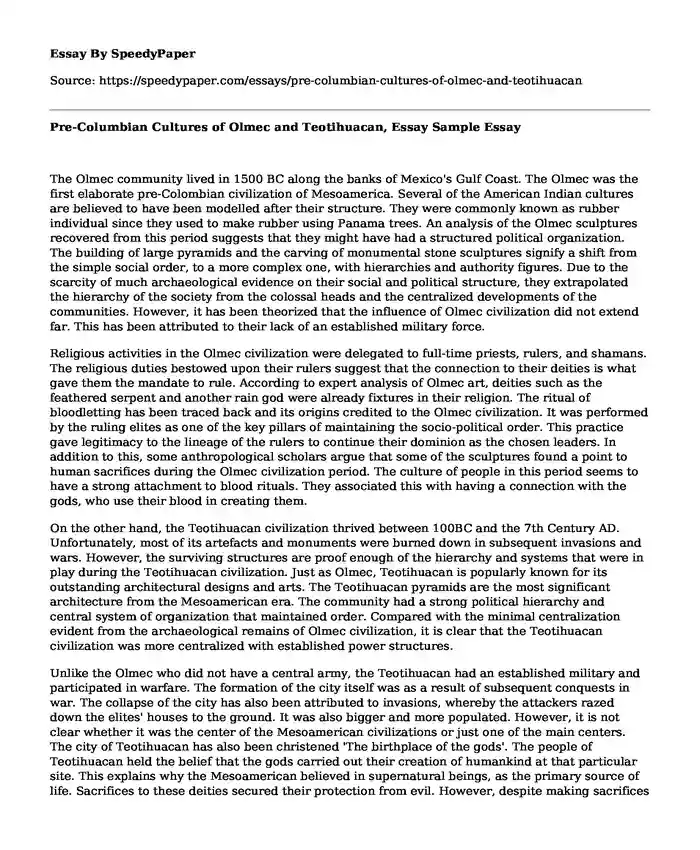The Olmec community lived in 1500 BC along the banks of Mexico's Gulf Coast. The Olmec was the first elaborate pre-Colombian civilization of Mesoamerica. Several of the American Indian cultures are believed to have been modelled after their structure. They were commonly known as rubber individual since they used to make rubber using Panama trees. An analysis of the Olmec sculptures recovered from this period suggests that they might have had a structured political organization. The building of large pyramids and the carving of monumental stone sculptures signify a shift from the simple social order, to a more complex one, with hierarchies and authority figures. Due to the scarcity of much archaeological evidence on their social and political structure, they extrapolated the hierarchy of the society from the colossal heads and the centralized developments of the communities. However, it has been theorized that the influence of Olmec civilization did not extend far. This has been attributed to their lack of an established military force.
Religious activities in the Olmec civilization were delegated to full-time priests, rulers, and shamans. The religious duties bestowed upon their rulers suggest that the connection to their deities is what gave them the mandate to rule. According to expert analysis of Olmec art, deities such as the feathered serpent and another rain god were already fixtures in their religion. The ritual of bloodletting has been traced back and its origins credited to the Olmec civilization. It was performed by the ruling elites as one of the key pillars of maintaining the socio-political order. This practice gave legitimacy to the lineage of the rulers to continue their dominion as the chosen leaders. In addition to this, some anthropological scholars argue that some of the sculptures found a point to human sacrifices during the Olmec civilization period. The culture of people in this period seems to have a strong attachment to blood rituals. They associated this with having a connection with the gods, who use their blood in creating them.
On the other hand, the Teotihuacan civilization thrived between 100BC and the 7th Century AD. Unfortunately, most of its artefacts and monuments were burned down in subsequent invasions and wars. However, the surviving structures are proof enough of the hierarchy and systems that were in play during the Teotihuacan civilization. Just as Olmec, Teotihuacan is popularly known for its outstanding architectural designs and arts. The Teotihuacan pyramids are the most significant architecture from the Mesoamerican era. The community had a strong political hierarchy and central system of organization that maintained order. Compared with the minimal centralization evident from the archaeological remains of Olmec civilization, it is clear that the Teotihuacan civilization was more centralized with established power structures.
Unlike the Olmec who did not have a central army, the Teotihuacan had an established military and participated in warfare. The formation of the city itself was as a result of subsequent conquests in war. The collapse of the city has also been attributed to invasions, whereby the attackers razed down the elites' houses to the ground. It was also bigger and more populated. However, it is not clear whether it was the center of the Mesoamerican civilizations or just one of the main centers. The city of Teotihuacan has also been christened 'The birthplace of the gods'. The people of Teotihuacan held the belief that the gods carried out their creation of humankind at that particular site. This explains why the Mesoamerican believed in supernatural beings, as the primary source of life. Sacrifices to these deities secured their protection from evil. However, despite making sacrifices to their eight gods, they did not embrace the concept of human sacrifice, as compared to the Olmec community. Nevertheless, Olmec religion was well developed and advanced compared to the Teotihuacan one.
Cite this page
Pre-Columbian Cultures of Olmec and Teotihuacan, Essay Sample. (2022, Apr 06). Retrieved from https://speedypaper.com/essays/pre-columbian-cultures-of-olmec-and-teotihuacan
Request Removal
If you are the original author of this essay and no longer wish to have it published on the SpeedyPaper website, please click below to request its removal:
- Should People Go To College or Not, Education Essay Sample
- Free Essay Sample on Southwest Airlines Strategy
- Free Essay Sample on Negatiation
- Essay Sample on the Factors That Foster Success in Teams
- Essay Example on 4 Types of Anxiety and Stress Disorders and How to Treat Them
- Paper Example: Figurative Comparisons
- Free Essay: Dual Admission Program
Popular categories





